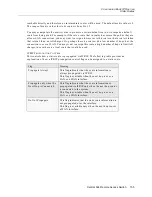
Central Site Remote Access Switch 151
C
ONFIGURING
B
ASIC
IP R
OUTING
IP Network Interfaces
with a remote device on a different subnet, the local device will ARP for the remote host’s MAC
address.
Since routers do not forward ARP requests across subnets, ARPs sent for hosts which are not
on the same physical network segment will go unanswered. The proxy ARP feature will
potentially generate an ARP reply for remote hosts. If the CyberSWITCH determines that it
provides the best route to the remote device, it will respond with an ARP reply containing the
MAC address of the CyberSWITCH. Further communication between the two hosts will then
be routed through the CyberSWITCH.
•
Secondary IP Addressing
If only one IP network interface (i.e., one subnet) per LAN port is configured, any traffic from
hosts on different subnets attached to the LAN port would be dropped.
With the secondary IP addressing feature, multiple IP network interfaces may be configured
for each LAN port. All existing subnets which are to be reached will have an associated IP
network interface on the CyberSWITCH. By allowing each LAN port to be configured with
multiple IP network interfaces, the CyberSWITCH can route packets from hosts on any of the
subnets attached to the LAN port. (See following example.)
Example: IP Host Communications in Flattened Networks
To communicate with destination hosts which are not on the same physical wire, you must have a
router attached to the edge of the flattened network which can forward packets to those destination
networks. In the following illustration, we are using a CyberSWITCH as our “edge” router:
ISDN
CSX5500
1.1.1.1
2.2.2.1
Host A
Host B
1.1.1.2
2.2.2.2
Host D
Host C
3.3.3.3
1.1.1.3
















































